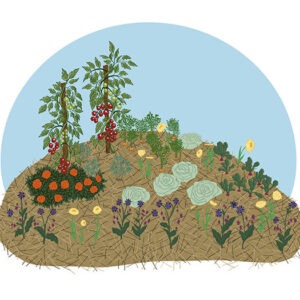Burying dead wood beneath a layer of soil is considered a magic formula for desert and dryland gardening.
As water resources become an increasing issue in our region and across the world, thinking about how we can conserve water is increasingly important, especially for those in love with growing their own produce.

Hügelkultur (German for hill or mound culture) is a regenerative gardening method known for its ability to keep a high moisture content in the soil, along with other benefits. Advocates of the method swear by it, saying it’s the silver bullet for desert and dryland gardening — without using irrigation.
At its simplest, hügelkultur is a method of burying dead wood beneath a layer of soil. The wood breaks down slowly over time, enriching the soil and creating air pockets that allow for a high oxygen content.
Due to its porous nature, the decaying organic matter is very good at retaining moisture in the soil. It acts like a sponge allowing the mound to retain a high moisture content for a long period of time without rain. There is much you can find on the internet about what woods you should and shouldn’t use in hügelkultur, and much of this depends on the wood you have available to you.
The consensus is that you shouldn’t use woods that have allelopathic properties, as these could harm the amount of microbiota in your soil. You also shouldn’t use woods that are very resistant to decomposing such as black walnut.
Finally, if you’re using freshly cut wood, you don’t want to immediately use something that will easily grow new trees from its cuttings, otherwise you’ll just end up with a new grove of trees.
Generally, a hügelkultur bed will have a base of large wood, smaller branches in the middle, and a layer of soil to top it off. It’s better to use larger pieces of wood (as opposed to wood chips, for example) as these will decompose more slowly and tie up less nitrogen in the soil.
Nitrogen is one of the crucial macronutrients plants need to grow, and since decomposition ties up nitrogen and prevents it from getting to plants, you want to make sure you’re controlling the amount that’s occurring.
Many claim this nitrogen issue will be the most in the first year of a hugel bed, and therefore avoid planting vegetables that are well known for needing high amounts of nitrogen as the first planting. Nitrogen-rich amendments like fully composted greens or fertilizer can also help this discrepancy.


